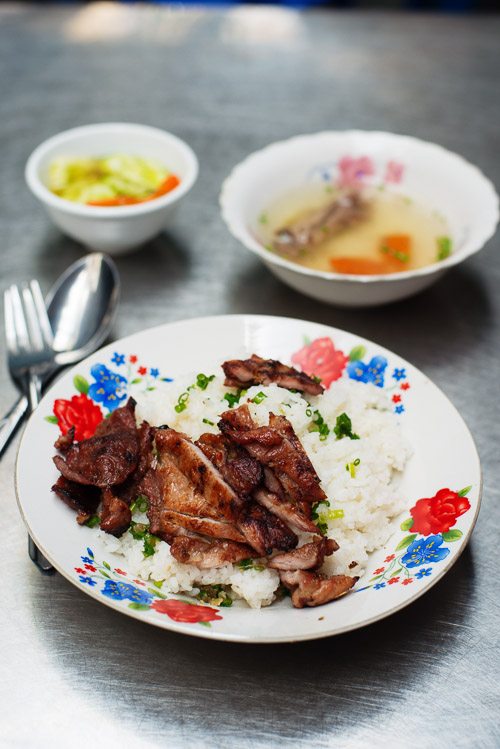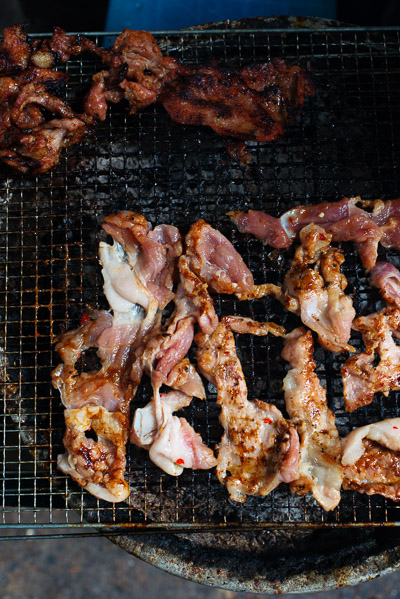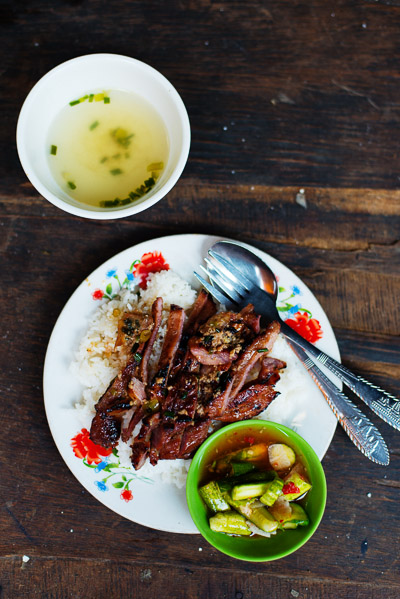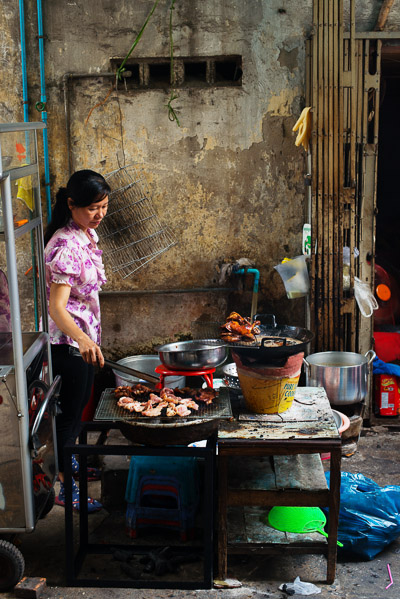 Bai sach chrouk -- rice and pork -- is the name of Cambodia's favourite breakfast dish, as well as a convenient description of what it entails: thin slices of meat served over rice.
Bai sach chrouk -- rice and pork -- is the name of Cambodia's favourite breakfast dish, as well as a convenient description of what it entails: thin slices of meat served over rice.
It's the simplest dishes that are often the most complicated, but I'm going to posit that this is not the case with bai sach chrouk. The dish seems to be sold on just about every corner in Phnom Penh, but I suspect that one would be hard-pressed to find a truly bad version. Conversely, I received blank stares when I asked people for the city's most famous bai sach chrouk vendors. I suppose that it's one of those rare dishes that generally operates to a single standard, one that's simple, consistent and delicious.
But of course there's more to bai sach chrouk than this.
Starting with the meat. Many vendors marinade the pork, which this being Cambodia, usually means a pleasant mild, balance of salty and sweet -- typically a combination of soy sauce and palm sugar, with perhaps some coconut milk. The important thing is that the the sugar contributes to a nice caramelisation and charring, and in the case of coconut oil (or pork fat) dripping and igniting the flames, a pleasant smokiness. The meat is usually grilled until it's pretty dry, and some vendors compensate for this by topping the dish with couple tablespoons of the marinade, sometimes supplemented with minced pork.
Rice, the other essential ingredient, is also unique. Bai sach chrouk is usually served over short, broken grains of rice. Phil Lees suggests that this is probably just a characteristic of the cheap rice used by most vendors rather than any conscious culinary decision. He's probably right, but to my mind at least, this minor detail has become an integral aspect of the dish, much like how a real Maine lobster roll is only served in a split-top bun.
The element that takes bai sach chrouk beyond its name is the sides. The dish is almost always served with a bowl of broth, typically nicked from the adjacent noodle vendor, and a small dish of pickles. The latter are generally made with cucumber, carrot and daikon, and are slightly sweet, but I've also encountered other versions, including a deliciously tart one made from shredded mango and slices of pungent 'fish mint' (Houttuynia cordata).
The final and possibly most important thing worth noting about bai sach chrouk is that it's a breakfast dish, which in Cambodia -- a country of early risers -- means that you'll be hard-pressed to find anybody making or eating it after 8am.
The good news is that bai sach chrouk is easy to recreate at any hour, even if you don't have access to exotic Asian ingredients. From Cambodian Cooking, by chef and buddy, Joannès Rivière:
Bai Sach Chrouk
3 cloves garlic, crushed with the flat side of a cleaver and peeled 5 tablespoons soy sauce 3 tablespoons palm sugar or dark brown sugar or honey 2/3 cup (150ml) coconut milk Freshly ground black pepper, to taste 14oz (400g) lean pork loin, thinly sliced
Combine the garlic, soy sauce, sugar or honey, coconut milk and black pepper in a shallow dish and mix well. Marinate the pork in this mixture for 1 hour.
Grille the pork over medium heat or roast it in a 400F (200C) oven, turning regularly until it's dried and starts to caramelise, about 15 to 20 minutes. Cut into strips and serve with rice and pickled vegetables [see recipe below].
Pickled Vegetables
1/2 cup (125ml) rice vinegar or white vinegar 1 tablespoon salt 6 tablespoons sugar 1 carrot, peeled and sliced into thin strips 1 daikon radish, peeled and sliced into thin strips 1/2 cucumber, peeled and sliced into thin strips 3 cloves garlic, peeled, left whole 3 bird's-eye chili peppers, coarsely chopped 3 sprigs coriander leaves (cilantro), roughly torn
Combine the vinegar, salt and sugar in a small saucepan and bring to a boil. Remove from the heat and set aside.
Combine the vegetables, garlic, chilies and coriander leaves in a bowl. Pour the vinegar mixture over the vegetables and marinate in the refrigerator overnight. Store the pickled vegetables in a glass jar with a tight-fitting lid in the refrigerator.
















